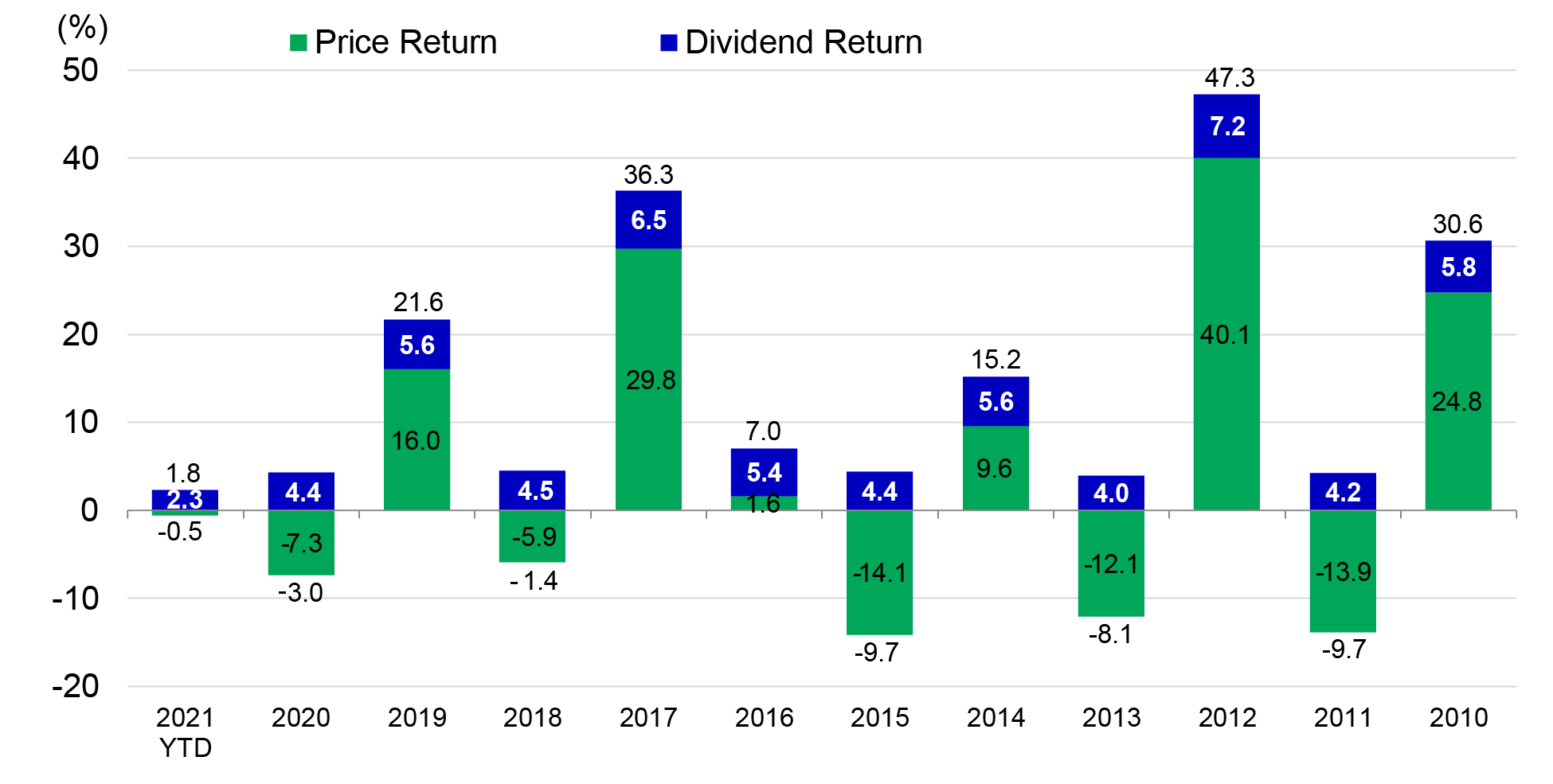Disclaimer (Singapore Investors)
Please read carefully these Terms and Conditions of Use (these "Terms") relating to access and use of this website. By clicking "accept" at the bottom of this page, you confirm that you agree to the Terms and Global Terms, and are an investor domiciled in Singapore. By clicking "accept" below, you also confirm that you consent to the setting of cookies on this machine to remember site preferences and track user activity. If you do not agree to be bound by or comply with the Terms or the Global Terms, or do not consent to the use of cookies, please do not access or use this website.
This website is operated by Manulife Investment Management (Singapore) Pte. Ltd. ("Manulife Singapore"), which is an entity regulated by Monetary Authority of Singapore. Manulife Singapore is a member of the Investment Management Association of Singapore (IMAS), and a fund management company included under the Central Provident Fund Investment Scheme (CPFIS).
Manulife Singapore reserves the right, in its sole discretion, to change, modify, add to, or remove portions of these Terms at any time. We suggest that you check these Terms periodically for changes. Any changes, modifications, or additions to, or deletions from these Terms shall be notified to you by, and effective upon, posting on this website. You agree that such notification of changes shall be sufficient notice for the purpose of this clause. If you use this website after we post changes to the Terms, you are deemed to have accepted the Terms as changed. If you do not agree to be bound by the changes, you shall immediately cease all access and/or use of this website. Manulife Singapore expressly reserves the right to monitor any use of this website.
You agree:- (i) to comply with all the notices, guidelines, rules and instructions pertaining to the use of the website as issued by Manulife Singapore from time to time and/or made available at this website, including all specific terms and conditions governing use of specific aspects of the website set out in any additional terms and conditions; (ii) to abide by all applicable laws and regulations in your use of the website; (iii) not to impersonate any person or entity or to falsely state or otherwise misrepresent your affiliation with any person or entity; (iv) not to upload or distribute in any way files that contain viruses, corrupted files or any other similar software, programs, macros or files that may impair or damage the operation of another's computer or handset; and (v) not to post, promote or transmit through the website any unlawful, harassing, libellous, harmful, vulgar, obscene or otherwise objectionable material of any kind or nature.
The information provided on this website is intended solely for use by Singapore residents and is not intended for distribution to, or use by, any person or entity in the United States, or any jurisdiction or country where such distribution or use would be contrary to law or regulation, or which would subject Manulife Singapore (including its affiliates) (collectively hereafter "Manulife") or any of Manulife's products or services to any registration requirement within such jurisdiction or country. Nothing on this website shall be considered as a solicitation to buy or an offer to sell a security or service to any person. Manulife Singapore does not claim that any products or services referenced in this site are available in any particular jurisdiction or appropriate for any particular investor. If you choose to access this website from a location outside Singapore, you do so on your own initiative, and you are responsible for compliance with any applicable local laws. By proceeding you are representing and warranting that you are either resident in Singapore or the applicable laws and regulations of your jurisdiction allow you to access the information on this website.
Manulife Singapore may from time to time without giving any reason or prior notice, upgrade, modify, alter, suspend, discontinue the provision of or remove, whether in whole or in part, this website and shall not be liable if any such upgrade, modification, suspension or alteration to the website prevents you from accessing the website or any part or feature thereof. The information and/or any other material contained in the website may be modified, deleted or replaced from time to time and at any time in the absolute discretion of Manulife Singapore. Any changes, modifications, or additions to, or deletions from these Terms or Global Terms shall be effective upon posting on this website. If you access this website, including the country-specific sections, after changes are posted to the Terms or Global Terms, you further acknowledge the Terms or Global Terms as changed and agree to be bound by them.
You will indemnify Manulife and their officers, directors, employees and agents in respect of any third party claim for any injury, loss, damage or expense occasioned by or arising directly or indirectly from your use of this website or any information or content therein, and/or the use or supply of information to a third party provided in breach of any of your obligations under these Terms.
Limitation of Liability on System and Transmission over the Internet
Manulife, or any of their respective directors, officers, employees or agents shall not liable for any event of Force Majeure, any virus or other harmful component affecting the website or any server that operates it, any interception of data or communications in connection with the public nature of the internet, any problems or technical malfunction of any telephone network or lines, computer online systems, servers or providers, computer equipment, software failure of any email or entry to be received on account of technical problems or traffic congestion on the Internet, telephone lines or at any website, or any combination thereof, including any loss of opportunities or profit arising from any time delay, system disruption or interruption, transmission blackout, delayed transmission or any incorrect data transmission, or any injury or damage to the computer or other electronic devices or property of any person accessing their website or any other person related to or resulting from accessing the websites or downloading any materials from the website of Manulife Singapore or any third party.
Manulife, or any of their respective directors, officers, employees or agents shall not be liable for any and all losses, injury (including special, indirect and consequential losses), damages, rights, claims and actions of any kind resulting from accessing or downloading any materials from the website of Manulife Singapore or any third party, including without limitation, personal injuries, death and property damage.
Except as specifically set forth herein or where the law requires a different standard, we shall not be responsible for any loss, damage or injury or for any direct, indirect, special, incidental, exemplary, or consequential damages, including lost profits, arising from or related to the system, equipment, browser and/or the installation or maintenance thereof, access to or use of the website, failure of electronic or mechanical equipment, the internet, the system, or communication lines, telephone or other interconnect problems, bugs, errors, configuration problems or incompatibility of computer hardware, software, the internet, or the system, failure or unavailability of internet access, problems with internet service providers, problems or delays with intermediate computer or communications networks or facilities, problems with data transmission facilities or any other problems you experience due to causes beyond our control.
Intellectual Property
All copyrights, trademarks, logos, service marks, trade names, or other intellectual property displayed on, or used in conjunction with, this website are proprietary to Manulife, unless otherwise indicated. All intellectual property and proprietary rights in the content, including but not limited to text, software, code, scripts, webpages, music, sound, photographs, video, graphics, graphical user interface, forms, diagrams or other material contained in the website belong to Manulife or the applicable third party service provider unless otherwise indicated. Manulife reserves all rights with respect to intellectual property ownership of all material on this website, and will enforce such rights to the full extent permissible by law. The material accessible on or through this website is made available for personal browsing and printing purposes only. You may access material displayed on this website for your non-commercial use only provided that you also retain all copyright and other proprietary notices contained on the materials. Users of this website may not otherwise:
- copy, reproduce, modify, sell, republish, post, transmit, or distribute in any way material from this website without the express, written permission of Manulife;
- use, copy, modify, or display any Manulife name, logo, text, or graphic image without Manulife's express, written permission;
- display any of the pages, text, images, or other content of this website using "framing" technology without Manulife's express written permission;
- use or reproduce the pages, text, images, or other content from this website for any purpose other than browsing or printing for personal, non-commercial use only;
- take any action to create an impression of affiliation, sponsorship, or endorsement between any user and/or website and Manulife; or
- insert a hyperlink to this website (or any part thereof) on any other website or webpage or "mirror" any material contained on this website on any other server or establish and/or maintain, on any website or webpage, any in-links, frame-links and/or any other type of hyperlinks to this website or any part thereof.
The website may contain content posted, emailed or otherwise submitted by you and/or, in the case of the website, by other users of the website (“User Content”). Manulife Singapore has the right to access and examine any User Content and may in its absolute discretion move, remove or disable access to User Content or cause the same to be done. You grant Manulife Singapore a perpetual, irrevocable, royalty free licence to use, reproduce, modify, adapt, publish, translate, incorporate in other works, distribute and display any information posted, emailed or otherwise submitted by you, in whole or in part.
Computer Equipment, Browser Access and Internet Services
You are responsible for obtaining, installing, maintaining and operating all software, hardware or other equipment (collectively, “System”) necessary for you to access and use and access this website. This responsibility includes, without limitation, your utilising up to date web-browsers and the best commercially available encryption, antivirus, anti-spyware, and internet security software. You are additionally responsible for obtaining Internet services via the Internet service provider of your choice, for any and all fees imposed by such Internet service provider and any associated communications service provider charges. You acknowledge that there are certain security, corruption, transmission error, and access availability risks associated with using open networks such as the Internet and you hereby expressly assume such risks, including, but not limited to those we may disclose in our materials. You acknowledge that you are responsible for the data security of the Systems used to access this website, and for the transmission and receipt of information using such Systems. You acknowledge that you have requested access to the website for your convenience, have made your own independent assessment of the adequacy of the Internet and Systems and that you are satisfied with that assessment. Manulife Singapore is not responsible for any errors or problems that arise from the malfunction or failure of the Internet or your Systems nor are we responsible for notifying you of any upgrades, fixes, or enhancements to, or for providing technical or other support for your Systems. Although we may provide a link to a third party site where you may download software, we make no endorsement of any specific software, hardware or Internet Service Provider and your use of any such software, hardware or service may also be subject to the license or other agreements of that provider, in addition to these Terms of Use.
Hyperlinks
We do not recommend or endorse and accept no responsibility for the content of any website not operated by Manulife Singapore which you may visit by following a link from this website. You acknowledge and agree that Manulife Singapore is not responsible for the availability of such third-party sites or resources, and do not endorse, approve, investigate or verify, and are not responsible or liable for any content, advertising, products, or other materials on or available from such sites or resources. You further agree that Manulife Singapore shall not be responsible or liable, directly or indirectly, for any damage or loss caused or alleged to be caused by or in connection with use of or reliance on any such content, products or services available on such external sites or resources. These links are provided as a convenience and solely for informational purposes. Manulife Singapore is not making any recommendation to invest in, purchase, or sell any securities or other products or services issued by the companies with the linked sites, nor has Manulife Singapore sought to verify or confirm the information contained in the linked sites. Accordingly, Manulife Singapore disclaims any responsibility for the linked sites.
No other website, without the prior written permission of Manulife Singapore, is authorized to link to any part of this website.
Investments
The contents on this website are for information only and without consideration given to the specific investment objective, financial situation and particular needs of any particular person and Manulife does not make any representation that the securities, investment products or services referred to, discussed on, or accessible through, this website are suitable for any particular investor. You should consider whether the security, investment product or service in question is suitable for you and may wish to seek professional advice before making a commitment to invest in any such security, investment product or to engage such service.
The contents on this website is not and should not be construed as being an offer to sell or a solicitation of an offer to buy any security or investment product that may be referred to, discussed on, or accessible through this website. Nor does this website constitute an offering or recommendation by Manulife of any security, investment product, investment management service, or advisory service. Manulife does not provide and should not be construed as providing investment advice, tax advice, or legal advice through this website, and you agree that this website will not be used by you for such purposes. You acknowledge that any requests that may be made by you for information on any security, investment product or service are unsolicited, and the provision of any information through this website shall not constitute or be considered investment advice, or an offer to sell, or a solicitation of an offer to buy any security, investment product or service.
Any forecasts or opinions set out on this website are Manulife's own as at the date of the relevant document and may change without notice and should not be regarded as a guarantee or indication of future or likely performance of the subject matter in question. Whilst Manulife believes that the information provided on this website is correct at the date of production, no warranty or representation is given to this effect and Manulife expressly disclaims liability for errors or omissions in such information. No reliance may be placed for any purpose on the information and opinions provided on this website or the accuracy or completeness thereof and no responsibility can be accepted by Manulife to anyone for any action taken on the basis of such information or opinions.
An offer of units in any fund referenced in this website may only be made in or accompanied by a prospectus and/or relevant offering document(s) in respect of such offer. The information and materials set out in this website is not to be taken as a substitute for the prospectus and/or offering document(s) of the relevant fund, as applicable, and you are advised to read the relevant documents (which are available and may be obtained from Manulife Singapore or any of its authorised distributors]) before applying for units in any fund.
Investments in any fund are not deposits in, guaranteed or insured by Manulife. The value of units in any fund and the income accruing to the units, if any, may fall or rise. Past performance is not necessarily indicative of future performance. You should be aware that investment in any fund involves financial risk and you may not get back the principal amount invested. Depending on your currency of reference, factors including but not limited to currency fluctuations may adversely affect the value of your investments and the income accruing there from.
On this website:
- The short name and full name of the following funds are as follows: Asia Pacific Investment Grade Bond Fund = Manulife Asia Pacific Investment Grade Bond Fund; Global Asset Allocation – Growth Fund = Manulife Global Asset Allocation – Growth Fund; SGD Income Fund = Manulife SGD Income Fund; Singapore Bond Fund = Manulife Singapore Bond Fund; Singapore Equity Fund = Manulife Singapore Equity Fund.
- The following are sub-funds of Manulife Global Fund:
Asia Dynamic Income Fund, Asia Pacific REIT Fund, Asia Total Return Fund, Asian High Yield Fund, Asian Short Duration Bond Fund, Asian Small Cap Equity Fund, China Total Return Bond Fund, China Value Fund, Dragon Growth Fund, Global Climate Action Fund, Global Equity Fund, Global Multi-Asset Diversified Income Fund, Global REIT Fund, Healthcare Fund, India Equity Fund, Preferred Securities Income Fund, Sustainable Asia Bond Fund, Sustainable Asia Equity Fund, U.S. Bond Fund, U.S. Equity Fund, U.S. Special Opportunities Fund.
- The following are sub-funds of Manulife Funds:
Asia Pacific Investment Grade Bond Fund, Global Asset Allocation – Growth Fund, SGD Income Fund, Singapore Bond Fund, Singapore Equity Fund.
Use of Email
The security of electronic mail sent through the Internet is not guaranteed. Do not send sensitive or confidential information to us via electronic mail. Delivery, and timely delivery, of electronic mail is also not guaranteed. Manulife therefore recommends that you do not send time-sensitive or action-oriented messages to us via electronic mail. Manulife may not, and is not obliged to, process your requests, orders, or instructions until Manulife can confirm your instructions or obtain appropriate written documentation where it deems necessary.
Manulife shall not be under any obligation whatsoever, express or implied, to reply to unsolicited correspondence, communications or email or to acknowledge receipt of the same.
Privacy and Data Protection
Your privacy is very important to Manulife. To the extent any information you provide or which we obtain from this website constitutes personal data, we have set procedures for the use of that information.
You agree that all information and/or particulars sent or submitted by you through the website is non-confidential and non-proprietary unless otherwise expressly indicated by you. You acknowledge that Manulife, its directors, officers, employees, contractors and agents shall not be subject to any confidentiality obligations in respect of any such information and/or particulars and you agree that Manulife, its directors, officers, employees, contractors and agents may, and you hereby authorise each of them to, use and to disclose such information to any person (including without limitation any third party service provider) in connection with Manulife's internal business purposes.
Without prejudice to the generality of the foregoing, you consent to the processing by Manulife of the personal data submitted by you through the website and/or created in the course of the business relationship with Manulife, and to the transmission of such personal data to other companies within the Manulife (by the internet or otherwise) for purposes connected with marketing and customer administration. If you do not wish your information to be used in this way, you should advise Manulife in writing.
If you have any questions on our data protection policies and practices, please write to us at our corporate address:
The Data Protection Officer
Manulife Investment Management (Singapore) Pte. Ltd.
8 Cross Street
#16-01 Manulife Tower
Singapore 048424
Disclaimers
Manulife does not warrant this website for any particular purpose. It is provided "as is" and on an "as available" basis. Manulife disclaims, to the fullest extent of the law, any warranty of any kind, whether statutory, express or implied, as to any information, materials, content or matter provided at or through this website or otherwise relating to this website, including without limitation the implied warranties of merchantability, fitness for a particular purpose, non-infringement of third party rights, or freedom from computer virus or other malicious destruction or corrupting code, agent, program or macros. Use of this website is at your own risk.
Manulife and its directors, officers, or employees will not be liable or have any responsibility of any kind for any loss or damage that you incur arising from or in connection with:
- any delay, termination, failure, defect, or interruption in the transmission of this website;
- any inaccuracy, error, unavailability, or incompleteness in the transmission of this website;
- any termination or interruption of your access to this website;
- your reliance on or use of this website;
- any e-mail requests, orders, or instructions you send, or the interception by third parties of any requests, orders, or instructions you send via e-mail;
- any act or omission of Manulife in making this website available to you; or
- any other cause relating to your access to or use of this website, whether or not the circumstances giving rise to such cause may have been within the control of Manulife or within the control of any other party providing software or services support for this website.
Manulife does not warrant that this website, or the functions contained in this website, will be uninterrupted or error-free, that defects will be corrected, or that this website, or the servers that make it available, are free from viruses or other harmful components. You assume the entire cost of any necessary servicing, repairing, or correcting of your property or operations as a result of using this website. You accept at your own risk that the Internet or other online communications medium may not perform as intended as a result of human, mechanical, or other error, despite the efforts of Manulife, you, or any third party.
In no event will Manulife or its directors, officers, or employees be liable to you for any direct, indirect, special, consequential, or incidental damages related in any way to your use of this website, even if: (a) such damages are reasonably foreseeable; or (b) Manulife or any other party has been advised of the possibility of such damages.
Records
You acknowledge and agree that Manulife Singapore's records and any records of communications, transactions, instructions or operations relating to the operation of the website and any record of any communications, transactions, instructions or operations maintained by Manulife Singapore or by any relevant person authorised by Manulife Singapore relating to or connected with the website shall be binding on you for all purposes whatsoever and shall be conclusive evidence of such communications, transactions, instructions or operations. You agree that such records are admissible in evidence and that you shall not challenge or dispute the admissibility, reliability, accuracy or the authenticity of the contents of such records merely on the basis that such records were in electronic form or were produced by or are the output of a computer system, and hereby waive any of your rights (if any) to so object.
Governing Law
These Terms shall be subject to, governed by, and construed in accordance with the laws of Singapore, and you hereby submit to the non-exclusive jurisdiction of the Singapore Courts.




